Because of the width of the Pasquotank River, ferries became a necessity for transportation in Camden. In 1740, a franchise was granted to Samuel Palmer to operate a ferry from Arenuse Creek to Newbegun Creek on the Pasquotank side, but the distance was too wide and his venture was unsuccessful. Later, John Solley operated a ferry from Chantilly to Relfe's Point (Cobb's Point) about one mile in distance. This proved to be a thriving business until 1777 when the northeast side of the county was formed into Camden County and Enoch Sawyer began to operate a ferry near the courthouse from his house at the Pecan Farm to the mouth of Knobb's Creek. Later, this ferry became known as Lamb's Ferry and remained in operation into the 20th Century. With the building of the "floating road" to Elizabeth City in 1923, Lamb's Ferry was discontinued.
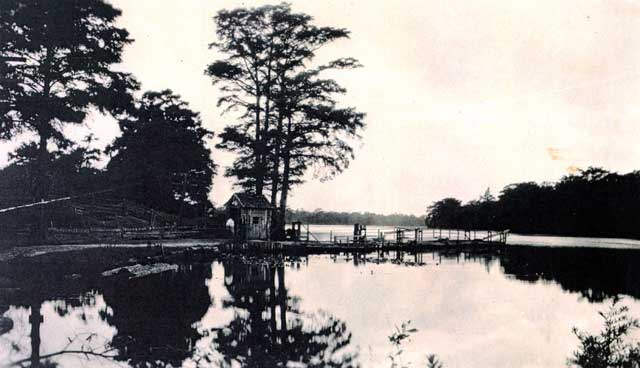 Lambs Ferry Bridge
Lambs Ferry Bridge
The building of the "Floating Road" was hailed by the Elizabeth City Daily Advance with the statement, "Camden may henceforth retain her own name, but from hence forth and forever in everything except name she is one with Pasquotank." Then in 1941, the Huffman Company began construction on the "Camden Causeway" by pumping 899,000 cubic yards of sand to create a 3 mile causeway to link Camden and Pasquotank counties.
Even though Camden has close ties and shares many services with Pasquotank, Camden is proud to be a small county. Camden County is the first and only consolidated city-county in the State of North Carolina, and it's county seat is the Courthouse Township of Camden. Camden County achieved this status in June of 2006, and became a Unified Government as of July 1, 2006. Camden residents take pride in their rural population, school system, and county government and they look forward to its future in the 21st Century.
Click to Enlarge
The red-brick Historic Camden County Courthouse was constructed beginning in 1846 following a fire that burned the original wooden county courthouse (which was built in 1782). The brick Courthouse, which stands on the site of the original courthouse, was completed in 1847. It is a Greek revival brick structure with a portico of four massive columns setting on brick piers.
Through the Civil War and throughout the latter-1800's, the Historic Courthouse was used as a courthouse, meeting place, and military encampment. The first known major work on the Historic Courthouse was done in 1898 when the Commissioners awarded contracts that year for fire-proofing portions of the building holding records of the Register of Deeds and the Clerk of Superior Court.
Click to Enlarge
The earliest known photo of the Historic Courthouse pre-dates 1908 and shows an adjacent hotel building. County Commissioner records show that on May 4, 1908, the Sheriff was ordered by the Commissioners to advertise the hotel building for sale and to sell the hotel building on that June 1, with removal no later than July 30. The hotel was removed to make way for the Old Jail that was constructed on that site in 1910.
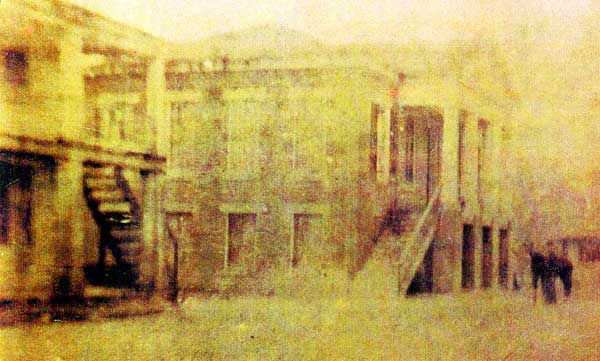
Although no known records exist, it appears there was extensive renovation of the building done in the period 1910 to 1925 with vaults created in the offices of the Register of Deeds and Clerk of Superior Court, electricity added to the building, and new flooring installed inside the courtroom. The last known staining and varnishing of the benches occurred in 1924 with a $45.00 contract, of which $15 was for painting the courtroom walls.
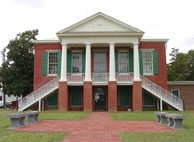 Glass Doors Added to Historic Courthouse
Glass Doors Added to Historic Courthouse
During the 1970's or 1980's, heating, venting and air conditioning was added to the building. Also during this period, the original wooden doors were removed from the first floor and replaced with glass doors, and burnt orange carpeting was installed. These improvements modernized the building for then-current times.
In 1996, a major addition to the Courthouse was constructed that added a new courtroom and bathrooms, expanded the area for the Clerk of Superior Court and the Register of Deeds and added an elevator for handicap accessibility. Construction of the addition did not significantly alter the Historic Courthouse, and the new brick siding complimented the old brick while differentiating between the old and new structures.
Click to Enlarge
Other than the 1920's and 1970's improvements, there has been no significant renovation of the Historic Camden County Courthouse since its opening in 1847. The current renovation seeks to maintain the historic integrity of the structure while making it a funtional building for the 21st century.
[Editors Note: In November of 2007, construction began on an addition that expanded the size of the Register of Deeds office. That construction was completed in August of 2008. The Register of Deeds office now enjoys a work area of 1496 square feet, a marked improvement over their previous office which was just under half that size.]
Click to Enlarge
After the Revolutionary War, the residents of Camden built a courthouse, jail and stocks in 1782 on property obtained from Thomas Sawyer at about the same spot of the present-day courthouse. There have been three courthouses and three jails located on this spot over the past 200 years. The wooden courthouse built in 1782 burned in 1846, thus a new brick one was built in 1847 and it served Camden until 1996. A new courthouse annex built in 1997 serves the county today.
The first jail was used until the 1880's; after which, a second jail was constructed. This one burned in 1910 as a result of an attempted prison escape. The third jail was built in 1910 at a cost of $6250. Services of this jail were discontinued in the 1940's when Camden began sending its prisoners to Pasquotank jail. Today, the tri-county (Pasquotank, Camden and Perquimans) jail houses prisoners from Camden.
The third jail, a two-story structure, has been restored to its original appearance. The first floor now houses the Board of Elections. The second floor has the original bull-pen containing 4 cells. Also on the second floor is a small museum which uses pictures and artifacts to relate the history of Camden. Outside, stocks and a pillory have been rebuilt to show punishment used in the 18th Century.
Click to Enlarge
While George Washington was president, construction began on the Dismal Swamp Canal. It began in 1793 and ended 12 years later in 1805. The construction of the canal proved to be one of the biggest events to take place in Camden County.
Boating and Kayaking on the Dismal Swamp Canal 205 years after completion of it's construction.
Click to Enlarge
In 1818, President James Monroe stayed overnight at the Farange Hotel near the present-day Dismal Swamp Welcome Center and also at the home of Enoch Sawyer at the Pecan Farm. He was the only known President to stay overnight in Camden.
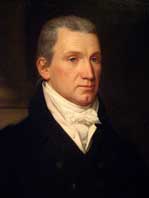
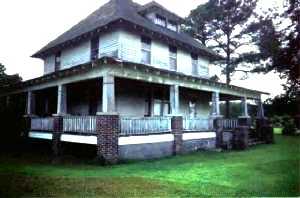
President James Monroe and the Historic Home of Enoch Sawyer
where President Monroe once stayed.
Life was simple in the late 1700's. When the first census was taken in 1790, Camden had a population of approximately 4100. Camden's population grew to 6733 in 1830, but by 1840, it had dropped to 5500. This population number was to remain fairly constant for the next 160 hears. Only in the year 2001, did the population of Camden surpass 7000.
[Editor's Note: From 1930 to 1990, there was a steady increase in population leading to a total population of 5904 in 1990, and then in 2000 the US Census Bureau reported a population total of 6885 for Camden County. The latest population estimate for Camden County from the US Census Bureau is 9682 residents living in Camden County for calendar year 2008.]
 Population Statistics from US Census Bureau 1930-2008
Population Statistics from US Census Bureau 1930-2008
In 1923, the building of the "Floating Road" was hailed by the Elizabeth City Daily Advance with the statement, "Camden may henceforth retain her own name, but from hence forth and forever in everything except name she is one with Pasquotank." Then in 1941, the Huffman Company began construction on the "Camden Causeway" by pumping 899,000 cubic yards of sand to create a 3 mile causeway to link Camden and Pasquotank counties.
Click to Enlarge
Even though Camden has close ties and shares many services with Pasquotank, Camden is proud to be a small county. Camden County is the first and only consolidated city-county in the State of North Carolina, and it's county seat is the Courthouse Township of Camden. Camden County achieved this status in June of 2006, and became a Unified Government as of July 1, 2006. Camden residents take pride in their rural population, school system, and county government and they look forward to its future in the 21st Century.
 The Courthouse Township of Camden is located approximately in the middle of the County of Camden. First known as Plank Bridge, George Washington made it a "port of entry" on Sawyer's Creek in 1790 and appointed Isaac Gregory its first Collector of Customs. Plank Bridge soon became a port of considerable maritime activity and the community grew. Joseph Jones attempted to establish a town there called Jonesboro. Wharves and warehouses dotted Sawyer's Creek but the town was doomed to failure as ships became larger and required deeper water; thus, a new develpment was started at the Narrows. The town of Redding, later called Elizabeth City, replaced Jonesboro as the commercial center of the Albemarle.
The Courthouse Township of Camden is located approximately in the middle of the County of Camden. First known as Plank Bridge, George Washington made it a "port of entry" on Sawyer's Creek in 1790 and appointed Isaac Gregory its first Collector of Customs. Plank Bridge soon became a port of considerable maritime activity and the community grew. Joseph Jones attempted to establish a town there called Jonesboro. Wharves and warehouses dotted Sawyer's Creek but the town was doomed to failure as ships became larger and required deeper water; thus, a new develpment was started at the Narrows. The town of Redding, later called Elizabeth City, replaced Jonesboro as the commercial center of the Albemarle.
With the formation of Camden County in 1777, the local government met at Joseph Jones home located in the center of the county. The county later purchased land in front of his home from Thomas Sawyer and built a courthouse, jail and stocks in 1782. As Jonesboro decline, the area was called Camden and soon became the focal point of the county as the seat of government and schools were located there. Camden has built 3 courthouses (1782, 1847 and an annex in 1997 [and an addition to the Register of Deeds in 2007]) and 3 jails (1782, ?, and 1910). Today, Camden utilizes the tri-county jail in Pasquotank to house its prisoners. The jail house, built in 1910, on the grounds of the Camden Courthouse has been restored and now houses the Board of Elections Office on the first floor and a museum on the second floor which showcases some of Camden's History.
There have been 3 jail houses built on the site where the current Historic Jailhouse now sits. The first jail was used until the 1880's; after which, a second jail was constructed. The second jail burned down in 1910 as a result of an attempted escape. The third jailhouse was constructed of brick, in 1910, and served the county until the 1940's when Camden began sending its prisoners to the Tri-County Jail, which currently houses prisoners from Camden, Pasquotank, and Perquimans.
The third jail, a two-story structure, has been restored to its original appearance. The first floor now houses the Board of Elections. The second floor has the original bull-pen containing 4 cells. Also on the second floor is a small museum which uses pictures and artifacts to relate the history of Camden. Outside, stocks and a pillory have been rebuilt to show punishment used in the 18th Century.
Watch Camden County Jail on PBS. See more from Our State.
Upcoming Events
| Mon Apr 29 @12:00PM - 05:00PM Library - LEGO Club Drop-In |
| Tue Apr 30 @10:00AM - Library Baby Storytime |
| Wed May 01 @ 3:30AM - 05:30PM Library Art Journal Session |
| Wed May 01 @10:30AM - Library Toddler Storytime |
| Thu May 02 @10:15AM - Senior Center Cooking Demo & Tasting |
| Thu May 02 @10:30AM - Library Big Kid Storytime |
| Fri May 03 @11:00AM - JCPC Board Meeting |
| Fri May 03 @ 1:00PM - Senior Center Movie and Popcorn |
| Sat May 04 @ 8:00AM - 01:00PM 19th Annual Paddle for the Border |
| Sat May 04 @11:00AM - 01:00PM Library Free Comic Book Day |
